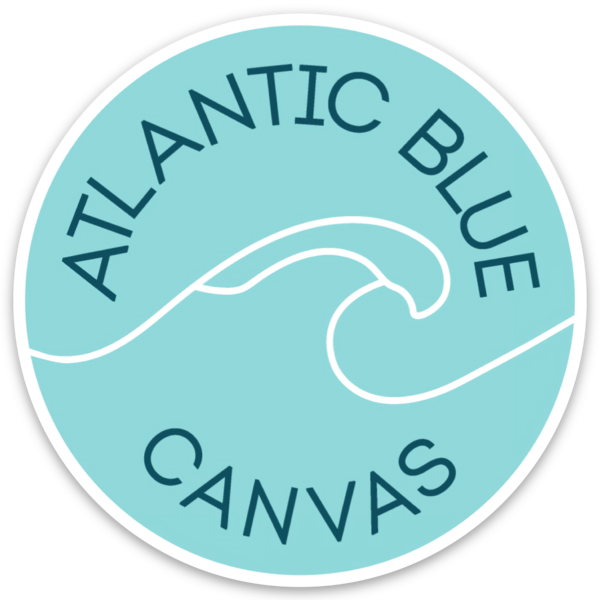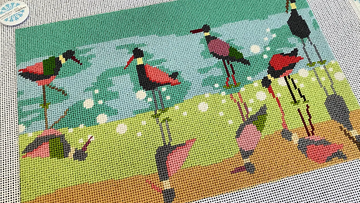Choosing the right needlepoint canvas is one of the most important steps in your stitching journey. Whether you’re picking up your first needle or leveling up your skills, your choice of canvas will shape how your project looks, feels, and how enjoyable it is to stitch.
From mesh counts to canvas types and project matching, this guide will help you confidently select a canvas that complements your style while ensuring your finished piece is beautiful and durable.
Why Canvas Choice Matters
The canvas you use influences every stitch you place:
-
Appearance: Mesh size and canvas type affect how detailed or bold your stitches appear.
-
Feel: The stiffness and structure of the canvas determine how comfortable it is to handle while stitching.
-
Durability: The right canvas keeps your project looking polished for years to come.
-
Ease of Stitching: Matching your canvas to your thread, stitch type, and project reduces frustration and helps you maintain even tension.
Choosing the right needlepoint canvas transforms stitching from a struggle into a satisfying, creative process.
Types of Needlepoint Canvas Explained
Not all canvases are the same, and understanding needlepoint types will help you choose wisely.
Mono Canvas
- Structure: Single-thread intersections form an even grid.
- Best For: All-purpose needlepoint, decorative stitches, shading, and most projects.
- Feel: Sturdy but slightly flexible, making it easier to manipulate while stitching.
- Tip: Perfect for beginners and experienced stitchers alike.
Interlock Canvas
- Structure: Threads are twisted and locked together for added stability.
- Best For: Beginners who want a non-fraying, easy-to-handle canvas.
- Feel: Softer and less prone to unraveling, but can be limiting for complex stitches.
-
Tip: Ideal for ornaments and small projects.
Penelope Canvas
- Structure: Dual-mesh design, allowing you to split threads for fine work or stitch over pairs for larger stitches.
- Best For: Projects requiring a mix of detailed and large-coverage areas.
- Feel: Heavier and very durable.
- Tip: Great for experienced stitchers who want flexibility in their designs.
Painted vs Printed vs Blank
- Hand-Painted Canvas: Designs are painted directly onto the canvas, providing clear color placement and unique artistry. Ideal for heirloom-quality projects where accuracy matters.
- Printed Canvas: Designs are screen-printed onto the canvas, offering clear guides at a lower cost. A great option for beginners looking to follow clear patterns while practicing how to needlepoint.
- Blank Canvas: For stitchers who want to design their own patterns or use charts, blank canvas offers total freedom. Best for advanced stitchers or those taking classes on designing custom work.
Mesh Count: What It Means and How to Choose
Mesh count indicates the number of holes per inch on your needlepoint canvas and determines the thread type you should use.
-
10-13 Mesh (Low Mesh):
- Larger holes, thicker threads (wool, heavy cotton).
- Best for beginners, bold designs, and quick coverage.
-
Easier on the eyes and hands.
- 14-18 Mesh (High Mesh):
-
- Smaller holes, finer threads (silk, stranded cotton).
- Allows for detailed, delicate designs.
-
Suitable for advanced stitchers or projects requiring shading.
What’s Best for Beginners?
For those learning how to needlepoint, 13-mesh mono canvas is the best place to start. It balances ease of stitching and detail while allowing you to master tension, thread coverage, and stitch techniques without frustration.
What’s Best for Pros?
Advanced stitchers may prefer 18-mesh for detailed shading or portrait-style projects, allowing fine stitches and intricate color blending.
Matching Canvas to Project Type
Different projects require different canvases for optimal results:
- Stockings: A 13-mesh mono canvas provides durability for years of use while showcasing vibrant designs.
- Ornaments: 18-mesh interlock canvas captures detail while keeping ornaments light and manageable.
- Pillows: 13-mesh mono canvas offers structure while displaying bold patterns beautifully.
- Bags and Clutches: Lower mesh provides durability for frequent handling, while Penelope canvas allows design flexibility.
- Wall Hangings: Choose based on desired detail, from 13 to 18 mesh, depending on the design’s complexity.
Buying Tips: What to Look for in a Quality Canvas
When purchasing your canvas, check:
- Mesh Consistency: Even holes without distortion.
- Canvas Firmness: Firm but flexible, ensuring it holds shape during and after stitching.
- Clarity: For printed or painted canvases, look for clear, crisp designs.
-
Edge Finish: Clean edges reduce fraying and make starting your project easier.
Where to Buy Needlepoint Canvases
Wondering where to buy needlepoint canvases that are high quality and inspiring?
Local needlepoint shops are excellent if you want to feel the texture and see colors in person, but online stores often offer broader selections and modern designs curated for today’s stitcher.
Atlantic Blue Canvas offers a carefully selected range of needlepoint canvases and beginner needlepoint kits, ensuring every stitcher, from beginner to advanced, finds a canvas that fits their style and skill level. Explore canvas options for ornaments, pillows, wall art, and more, and check out beginner-friendly kits to start your next project with ease.
How Canvas Choice Impacts Stitching Techniques
Your needlepoint canvas choice will affect:
- Stitch Types: Lower mesh is ideal for tent stitch and basketweave, while higher mesh allows decorative stitches like French knots and shading techniques.
- Thread Types: Match thread weight to mesh size for optimal coverage.
- Tension Management: A firm, consistent canvas helps maintain stitch tension, resulting in a smoother finished look.
Advanced Canvas Tips for Confident Stitchers
For those ready to explore beyond basics:
- Try Penelope canvas for designs with mixed detail and bold areas.
- Use metallic threads on higher mesh canvases for sparkle without bulk.
- Experiment with decorative stitches on small canvas scraps to see how they behave with different mesh counts.
- Keep your canvas taut using stretcher bars for larger pieces to avoid warping.
Conclusion
Your choice of needlepoint canvas will directly impact your stitching experience and the quality of your finished piece. By understanding canvas types, mesh counts, and project matching, you can confidently choose a canvas that aligns with your vision and skill level.
Whether you’re stitching a keepsake ornament, a vibrant pillow, or an heirloom holiday stocking, selecting the right canvas ensures your project is enjoyable to stitch and beautiful to display.
Ready to choose your next project? Discover your ideal canvas and kit with Atlantic Blue Canvas and start stitching confidently.
FAQs
What’s the best canvas for tent stitch?
Mono canvas (13 mesh) is perfect for tent stitch, offering an even surface and excellent stitch alignment.
Can I reuse a needlepoint canvas?
Technically yes, but removing stitches can distort the mesh, and old holes may remain visible, impacting the final appearance of your new project.
Do I need a frame for needlepoint?
While you can stitch without a frame, using stretcher bars or a frame helps maintain even tension and prevents warping, especially for larger projects.
Should beginners start with printed or painted canvas?
Printed or painted canvases are highly recommended for beginners, providing clear design guidance and allowing you to focus on stitching technique.





